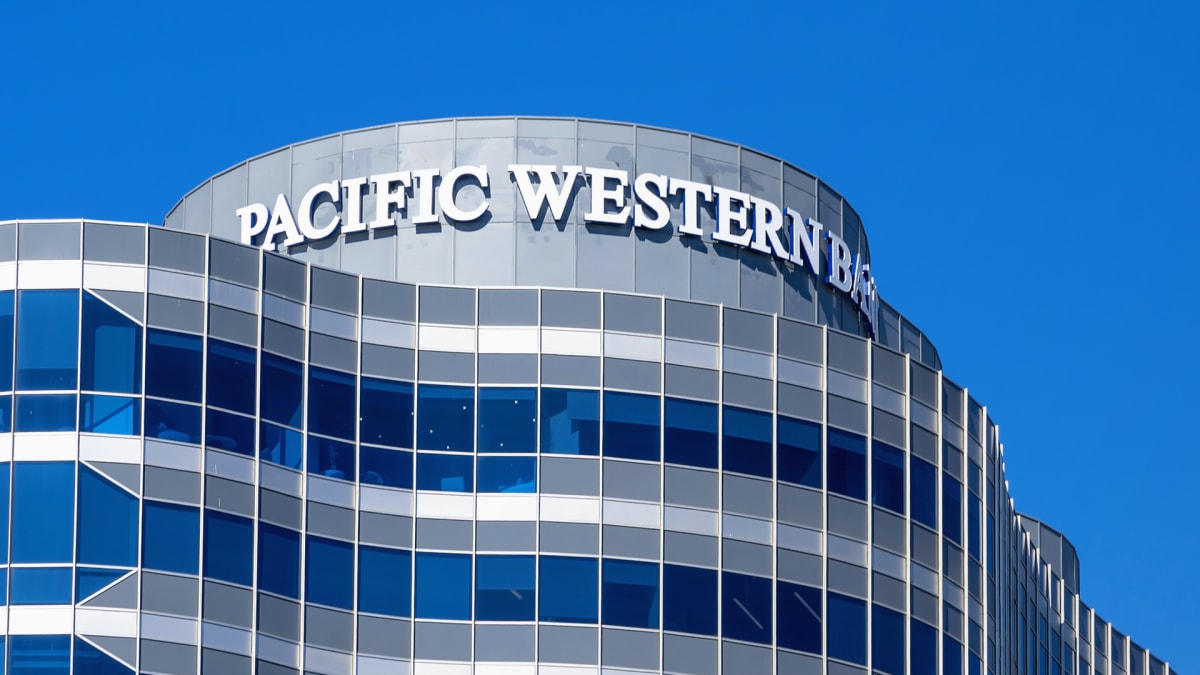
Is PacWest Bancorp. the next U.S. bank to fall?
The pressure has never been so huge on the Los Angeles, Calif.-based firm, which is now seen as the new weak link among American regional banks.
PacWest shares have fallen nearly 37% since First Republic Bank failed on April 30. But the tumble is bigger than that as stock prices fell more than 52.4% in after-hours on May 3 on Wall Street. PacWest shares were trading around $3.05 at last check compared to $6.42 at the close.
'Discussions Are Ongoing'
The reason for the stock market rout was a Bloomberg News report indicating that the bank was exploring various strategic options including its possible sale. PacWest (PACW) did not hesitate to react. The bank did not deny information from Bloomberg News. It said that it has been approached by potential buyers and investors but added that discussions were continuing.
"Our message remains consistent with what was conveyed last week with earnings," the bank said in a statement that you can read here. "As previously announced, the company has explored strategic asset sales, including moving the $2.7 billion lender finance loan portfolio to held for sale in 1Q23.
It said that: "this planned sale remains on track", and upon completion it will reinforce its liquidity.
PacWest, however, said the company and its board of directors "continuously review strategic options."
"Recently, the company has been approached by several potential partners and investors - discussions are ongoing. The company will continue to evaluate all options to maximize shareholder value," the bank said, without providing names.
No 'Unusual' Deposit Outflows: Western Alliance
PacWest also addressed the problem of outflows, which particularly agitates investors. The four banks that have fallen since March have seen their fall precipitated by bank runs from customers panicking to lose their money in the event of default.
"The bank has not experienced out-of-the-ordinary deposit flows following the sale of First Republic Bank and other news," PacWest said. "Core customer deposits have increased since March 31, 2023, with total deposits totaling $28 billion as of May 2, 2023 with insured deposits totaling 75% vs. 71% at quarter end and 73% as of April 24, 2023."
It added that it recently paid down $1 billion of borrowings with its excess liquidity.
"Our cash and available liquidity remains solid and exceeded our uninsured deposits, representing 188% as of May 2, 2023."
It is difficult to know if these statements will restore calm. It is important to remember that First Republic Bank made almost similar comments two days before its sale to JPMorgan Chase by the Federal Deposit Insurance Corporation on May 1.
Besides PacWest, Western Alliance (WALPL) , another U.S. regional bank, is also raising concerns from investors. It tried to quell doubts as well, by saying, in a statement, that it has not experienced "unusual deposit flows" following the sale of First Republic Bank.
"Total Deposits were $48.8 billion as of Tuesday, May 2, up from $48.2 billion as of Monday, May 1, and flat to Friday, April 28. Quarter to date, deposits are up $1.2 billion from $47.6 billion as of March 31," the firm which is based in Phoenix said.
The current banking crisis of confidence, the worst since the 2008 financial crisis, really began with the failure of Silicon Valley Bank on March 10 even though two days earlier Silvergate Bank, a central lender for the crypto industry, had ceased its operations.
SVB was the go-to lender for many tech companies. It provided specialized financial services, industry expertise, a valuable network, and a strong reputation. Beyond that, SVB appeared to benefit from a strategy many banks adopted when the pandemic hit and the Fed cut interest rates to near zero to avert the economy entering a severe recession.
'The Regional Banking System Is at Risk': Bill Ackman
To attract customers, SVB (SIVB) offered higher interest rates on deposits than its larger rivals did. The company then invested its clients' money in long-dated Treasury bonds and mortgage bonds with strong returns.
This strategy had worked well in recent years. The bank’s deposits doubled to $102 billion at the end of 2020 from $49 billion in 2018. In 2022, deposits increased to $189.2 billion.
But everything turned upside down when the Federal Reserve began to raise interest rates, which made existing bonds held by SVB less valuable. The bank had to sell the bonds at a discount to cover withdrawals from its customers. In selling these bond positions, SVB had to take a loss of $1.8 billion.
Due to this loss, SVB suddenly announced that it needed to raise additional capital of $2.25 billion, by issuing new common and convertible preferred shares. This decision caused panic and a run on the bank.
For investors, there is no longer any doubt: most regional banks are sitting on unrealized losses. Added to this is another big problem: uninsured deposits. The FDIC guarantees deposits up to $250,000 only. Basically, all individuals or businesses with more than $250,000 in their accounts would lose anything above the FDIC threshold if the bank defaulted.
The U.S. regulators also closed Signature Bank in New York on March 12 because of a bank run. Convinced that the bleeding is not over, investors are now trying to identify the next victim.
"The regional banking system is at risk," warned hedge fun billionaire Bill Ackman on Twitter on May 3. "SVB's depositors' bad weekend woke up uninsured depositors everywhere. The rapid rise in rates impaired assets and drained deposits. Zeroing out shareholders and bondholders massively increased the banks’ cost of capital. CRE [commercial real estate loan] losses loom."
The legendary investor is very pessimistic.
"Confidence in a financial institution is built over decades and destroyed in days," Ackman said. "As each domino falls, the next weakest bank begins to wobble. Until investors are rewarded for betting on a wobbling bank, there will be no bid, and the best sale is the last price."







